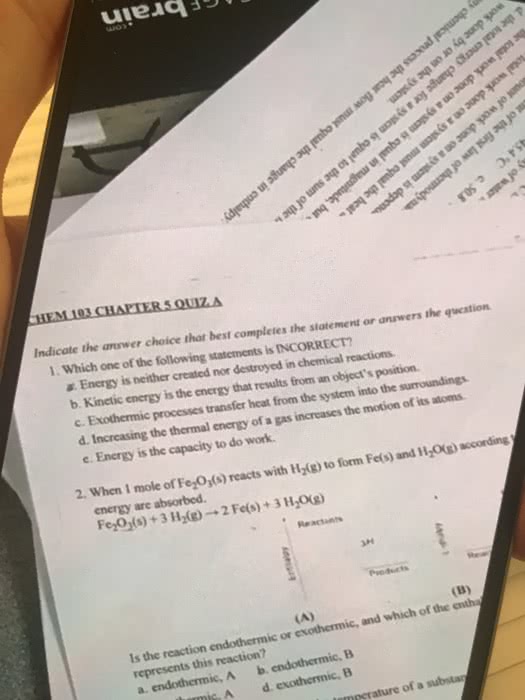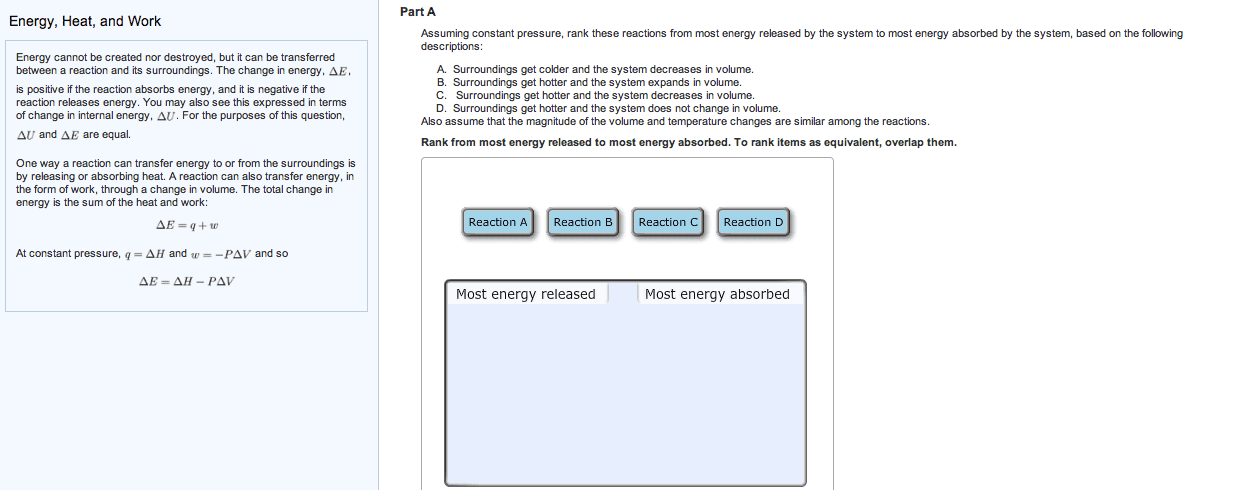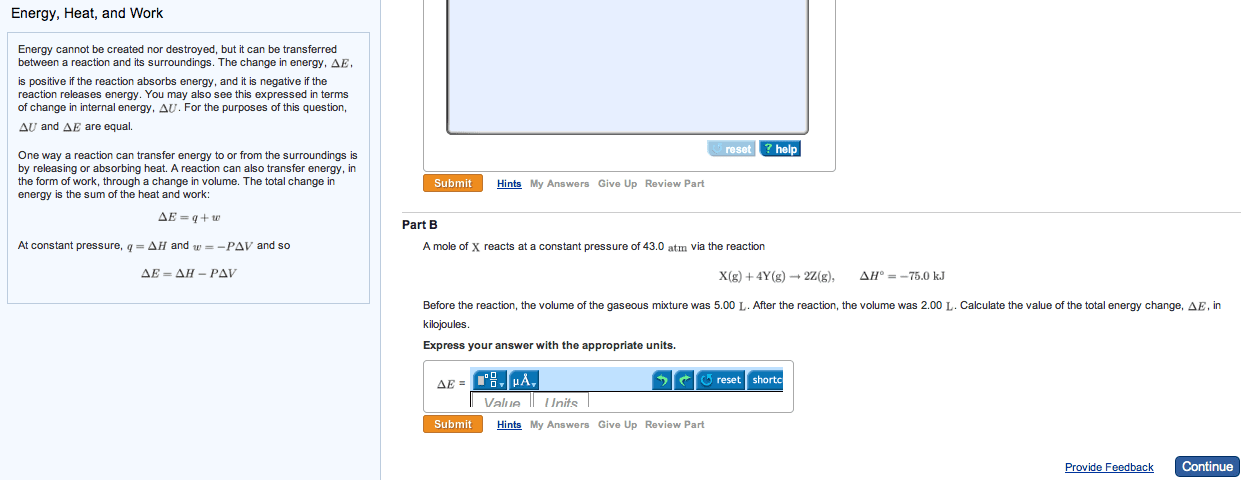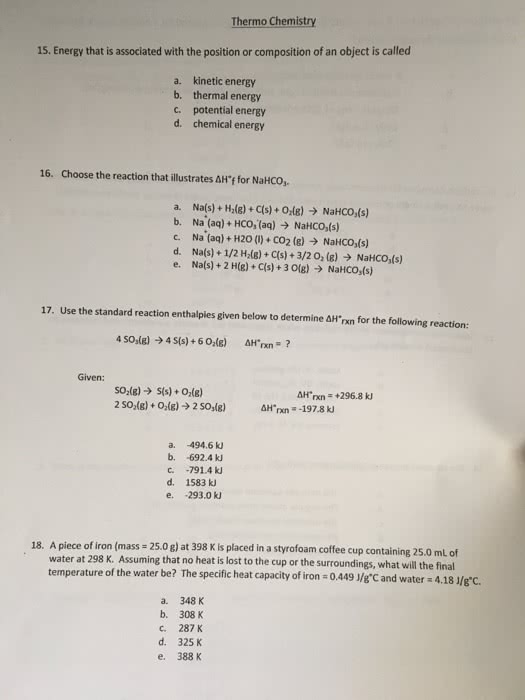CHEM 217 Lecture Notes - Lecture 6: Intensive And Extensive Properties, Endothermic Process, Chemical Equation

Unit 6
6 . 1 C H E M I C A L H AN D W A R ME R S
oInvolves principals of thermochemistry: study of relation between chemistry and energy
oOpen the package and expose to air and exothermic reaction occurs
oMost common use oxidation of iron as exothermic reaction
o4Fe(s) + 3O2 (g) -> 2Fe2O3 (s)
most important product is the heat and not the substance
Size of temperature increase is proportional to the amount of heat released by the
reaction
oChemical reaction can exchange energy with surroundings and how to quantify the magnitude of
exchanges
6 . 2 N A T U R E O F E N E R G Y : K E Y D EFI N IT I O N S
oEnergy is the capacity to do work – we defined work (w) as a result of force acting through a distance
oEnergy can also be transferred through heat (g), the flow of energy cause by temperature difference
oEx. if you hold a cup of coffee, energy transferred in the form of heat to your cooler hand
oThink of energy as something an object (s) posess(es)
oThink of heat and work, as ways that they exchange energy
oEx. curling stone – an example of kinetic energy associated with motion of an object
oEnergy in a hot cup of coffee is thermal energy, the energy associated with the temperature of an object –
but actually a type of kinetic energy because it arises from motions of atoms or molecules within a
substance
oWater @ top of waterfall has potential energy – the energy associated with the position or
composition of an jobject
oChemical energy is the energy associated with relative positions of electrons and nuclei in atoms
and molecules is also a form of potential energy. Some chemical compounds are like a
compressed spring
LAW OF CONSERVATION OF ENERGY: NEITHER CREATED OR
DESTROYED
oSystem: anything you study
oThe system’s surroundings are everything w/which the system can exchange energy
oIf system loses energy, the surroundings gain that exact amount of energy
find more resources at oneclass.com
find more resources at oneclass.com

oUnits of energy: Can deduce units form definition of kinetic energy
oAn object of mass m, moving at velocity v has a kinetic energy KE given by:
KE=1/2mv2
m in kg
v in s-1
oSI unit of mass is kg and the unit of velocity is ms-1
oThe SI unit of energy is therefore kgm2s-2 defined as the Joule (J)
1 kg m-2s-2=1J
oJoule is very small
Ex. light bulb uses 3.6 x 105 J in an hour so we use kJ
1kJ = 1000J
oSecond common unit is calorie (cal), originally defined as the amount of energy required to raise the
tempereature of 1g water by 1C
oCurrent definition: 1cal=4.184J (exact) – larger unit than a J
oRelated energy unit is nutritional or uppercase “C” Calorie (Cal) equivalent to 1000 lowercase “c”
calories
The Calorie is equal to a kilocalorie (kcal)
(kcal): 1 Cal = 1 kcal = 1000 cal
Electricity bills based on larger energy unit, the kilowatt-hour (kWh): 1kWh=3.60x106J
6 . 3 F I R S T LA W O F TH E R M O D Y N A MIC S : N O F R E E LUN C H
oLaw of energy conservation
oThe total energy of the universe is constant
oyou don’t get something for nothing – best you can do is break even
oa perpetual motion machine can not exist
oInternal energy
oInternal energy (U) of a system is the sum of kinetic and potential energies of all of the particles
that compose the system
oInternal energy is a state function: its value depends only on the state of the system, not on how
it arrived at that state
oState of a chemical system specified by parameters like temperature, pressure, concentration,
and physical state (s,l,g)
find more resources at oneclass.com
find more resources at oneclass.com

oLike altitude change for mountain climbing, an internal E! ^U for a chemical reaction or physical ^ is
determined by difference in internal E! between final and initial states
o^rU=Ufinal – Uinitial
In a chemical system, the reactants constitute the initial state
^rU = Uproducts – Ureactants
difference in internal energy written as ^rU and has units of kJ mol-1
indicating ^ in interal energy per mol of reaction as written ^U is an
internal energy ^ for a process in units of kJ – in this text, we use ^rU to
indicate a molar internal energy change.
oNote that for any process, the sign of ^U & ^rU are the same
oC + O2 -> CO2
For this reaction, the reactants are higher, as reactions
occurs, reactants become products with lower internal
energy
Energy given off by reaction is &rU is negative
oWhere does energy lost by reactants go? If reactants and
products are the system, then energy flows out of system into
surroundings
oSystem -> energy flow ->surroundings
o^Usystem < 0 (negative)
o^Usurroundings > 0 (positive)
oLaw of conservation : ^ Usys= -^Usurr
oIf we change it reverse: CO2 -> C + O2
Energy diagram nearly identical but internal energy increasing
^rU is positive and energy flows into the system from surroundings
oSystem can exchange energy through heat (q) and work (w)
o^ in internal energy of the system (^U) is the sum of the heat transferred (q) & all the
work done (w)
^U = q+w
^U is internal energy of the system
oWhile ^U is a state function, q and w are not
Ex. however the curling stone gets to where it is ^U will be the same but q&w may not
Sum of q & w (which is ^U) is constant
6 . 4 Q U A N T I F Y I N G H E A T A N D W O R K
find more resources at oneclass.com
find more resources at oneclass.com
Document Summary
1 c h e m i c a l h a n d w a r m e r s o. Involves principals of thermochemistry: study of relation between chemistry and energy: open the package and expose to air and exothermic reaction occurs, most common use oxidation of iron as exothermic reaction o. 4fe(s) + 3o2 (g) -> 2fe2o3 (s) most important product is the heat and not the substance. Size of temperature increase is proportional to the amount of heat released by the reaction o. Chemical reaction can exchange energy with surroundings and how to quantify the magnitude of exchanges. 2 n a t u r e o f e n e r g y : k e y d e f i n i t i o n s o o. Energy is the capacity to do work we defined work (w) as a result of force acting through a distance.





